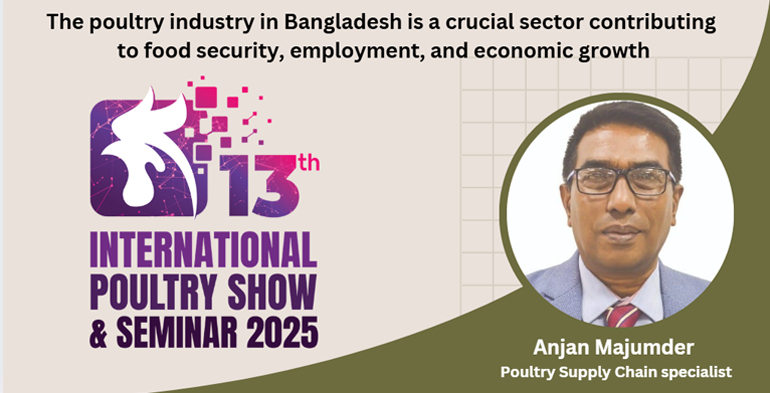
Anjan Majumder: Bangladesh’s poultry industry has significant growth potential, driven by rising demand, urbanization, and value-added product expansion. However, addressing disease risks, improving food safety, and strengthening the supply chain are crucial for long-term sustainability. With proper government policies, investment in technology, and consumer awareness, the sector can play a major role in ensuring food security and economic development
Here’s a detailed breakdown of its opportunities, risks, threats, scope, consumer behaviors, trends, food safety, security, post-harvest scope, processing, supply chain, and welfare aspects.
- Opportunities in the Bangladesh Poultry Industry
Growing Demand: Rising population, urbanization, and increasing disposable income drive higher demand for chicken and eggs.
Export Potential: Opportunities for halal poultry exports to Middle Eastern and Asian markets.
Government Support: Policies like tax exemptions, subsidies, and funding for poultry farmers.
Technological Advancements: Adoption of automation, genetic improvements, and modern farming techniques.
Integration with Agro-Industry: Demand for poultry feed (maize, soybean), pharmaceuticals, and veterinary services.
Fast Food & Processed Chicken Growth: Expansion of Quick Service Restaurants (QSRs) like KFC and local chains increases demand for processed chicken.
- Risks & Threats:
Disease Outbreaks: Avian influenza, Newcastle disease, and other poultry diseases can disrupt production.
Feed Price Volatility: Dependence on imported soybean and maize affects costs.
Climate Change Impact: Extreme weather conditions affect poultry farming and feed production.
Market Competition: Rising competition from imports and large-scale integrated poultry firms.
Lack of Proper Regulation: Inconsistent enforcement of biosecurity measures.
Public Health Concerns: Overuse of antibiotics and food safety issues may lead to consumer distrust.
- Scope & Growth Potential:
Expansion of Layer & Broiler Farming: Small, medium, and large-scale commercial farms are Potential.
Organic & Free-Range Poultry: Rising awareness of organic meat and eggs opens a niche market.
Value-Added Products: Processed items like nuggets, sausages, and frozen chicken have increasing demand.
Rural Employment & Women Empowerment: Small-scale poultry farms provide livelihood opportunities.
Poultry Waste Utilization: Using waste for biogas and organic fertilizer creates additional revenue.
- Consumer Behaviors & Market Trends:
Preference for Fresh Chicken: Live bird markets still dominate, but demand for frozen and processed chicken is rising.
Health Consciousness: Consumers are shifting toward antibiotic-free and organic poultry products.
Demand for Convenience Foods: Urban consumers prefer ready-to-cook or ready-to-eat chicken products.
E-commerce & Online Sales Growth: Platforms like Chaldal, Daraz, and Meena Click facilitate online poultry sales.
Influence of Fast Food Chains: Urbanization drives demand for fried and grilled chicken products.
- Food Safety & Security Concerns:
Antibiotic Residues: Overuse of antibiotics in poultry production raises food safety concerns.
Adulteration Issues: Unregulated use of growth promoters and harmful preservatives.
Lack of Cold Chain Infrastructure: Poor transportation and storage facilities impact meat quality.
Consumer Awareness Growing: More consumers are demanding hygienic and certified poultry products.
Regulatory Gaps: Bangladesh Food Safety Authority (BFSA) enforces safety standards, but challenges remain in rural areas.
- Post-Harvest Scope & Processing:
Meat Processing Industry Growth: Increased investments in slaughterhouses and meat processing plants.
Automation in Processing: Large players are investing in automated processing and packaging.
Frozen vs. Fresh Market: Growing acceptance of frozen poultry, but fresh markets remain dominant.
Cold Chain Development: Need for better refrigeration and storage facilities to maintain meat quality.
Waste Management & By-Product Utilization: Potential for processing poultry waste into value-added products like pet food, fertilizer, and biofuel.
- Poultry Supply Chain Overview:
Farm to Market Flow: Breeders → Hatcheries → Feed Mills → Poultry Farms → Wholesalers → Retailers → Consumers.
Challenges in Logistics: Transportation issues, lack of cold storage, and middlemen reducing profit margins.
Integration & Contract Farming: Big companies like kazi, CP Bangladesh & some others company are adopting vertically integrated models.
Price Fluctuations: Seasonal demand variations and production costs impact stability.
- Poultry Welfare & Ethical Considerations:
Better Farming Practices: Shift toward improved housing systems, reduced stocking density, and better ventilation.
Ban on Growth Hormones: Although illegal, strict monitoring is required to ensure compliance.
Slaughterhouse Regulations: Need for more humane slaughtering methods and hygienic processing plants.
Corporate Social Responsibility (CSR): Large poultry firms are focusing on sustainability and animal welfare.
The future of Bangladesh’s poultry industry looks promising, but addressing challenges related to environmental impact, disease control, and economic stability is essential. With the right policies, technological advancements, and sustainable farming practices, the industry can continue to thrive while maintaining long-term sustainability.
Writer: Poultry Supply Chain specialist